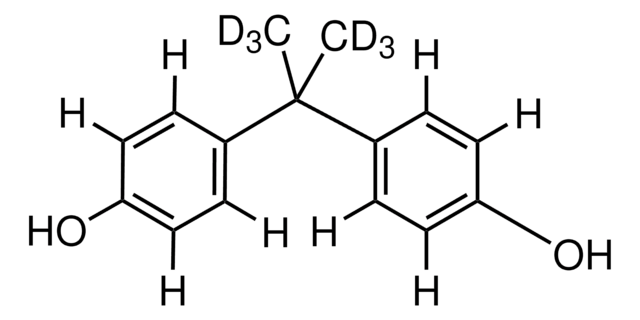239658
Bisphenol A
≥99%
Synonyme(s) :
2,2-Bis(4-hydroxyphenyl)propane, 4,4′-Isopropylidenediphenol
About This Item
Produits recommandés
Pureté
≥99%
Forme
solid
Point d'ébullition
220 °C/4 mmHg (lit.)
Pf
158-159 °C (lit.)
Chaîne SMILES
CC(C)(c1ccc(O)cc1)c2ccc(O)cc2
InChI
1S/C15H16O2/c1-15(2,11-3-7-13(16)8-4-11)12-5-9-14(17)10-6-12/h3-10,16-17H,1-2H3
Clé InChI
IISBACLAFKSPIT-UHFFFAOYSA-N
Informations sur le gène
mouse ... Esr1(13982)
rat ... Ar(24208)
Vous recherchez des produits similaires ? Visite Guide de comparaison des produits
Catégories apparentées
Description générale
Application
- Quantitative analysis of bisphenol A and bisphenol S in three plastic product samples of a mineral water bottle, polycarbonate bottle, and baby bottle, using a modified glassy carbon electrode (GCE) sensor based on a crystalline covalent organic framework (COF)
- Simultaneous determination of bisphenol A, S, and F in 112 samples of thermal paper receipts by liquid chromatography coupled to mass spectrometry (LC-MS) following their ultrasound-assisted extraction
- Development and validation of a gas chromatography-tandem mass spectrometry (GC-MS/MS) method for the measurement of bisphenol A and 18 BPA-related compounds in 30 breast milk samples after their solid phase extraction (SPE)
- Construction of an electrochemical sensor based on multi-walled carbon nanotubes (MWCNTs) modified glassy carbon electrode (GCE) for the determination of bisphenol A & S in river water and thermal paper samples by cyclic voltammetry (CV)
- Determination of bisphenol A in urine samples using a novel method based on miniaturized QuEChERS extraction and gas chromatography-mass spectrometry (GC-MS)
- Investigate the bisphenol A content from glass or Pasteur pipettes in biological liquids from maternal women using high-performance liquid chromatography (HPLC).
Mention d'avertissement
Danger
Mentions de danger
Conseils de prudence
Classification des risques
Aquatic Acute 1 - Aquatic Chronic 1 - Eye Dam. 1 - Repr. 1B - Skin Sens. 1 - STOT SE 3
Organes cibles
Respiratory system
Code de la classe de stockage
6.1C - Combustible acute toxic Cat.3 / toxic compounds or compounds which causing chronic effects
Classe de danger pour l'eau (WGK)
WGK 3
Point d'éclair (°F)
440.6 °F - closed cup
Point d'éclair (°C)
227 °C - closed cup
Équipement de protection individuelle
Eyeshields, Faceshields, Gloves, type P3 (EN 143) respirator cartridges
Certificats d'analyse (COA)
Recherchez un Certificats d'analyse (COA) en saisissant le numéro de lot du produit. Les numéros de lot figurent sur l'étiquette du produit après les mots "Lot" ou "Batch".
Déjà en possession de ce produit ?
Retrouvez la documentation relative aux produits que vous avez récemment achetés dans la Bibliothèque de documents.
Les clients ont également consulté
Protocoles
A comprehensive sample preparation and analytical procedure was developed by Supelco for determining BPA in drinking water.
Notre équipe de scientifiques dispose d'une expérience dans tous les secteurs de la recherche, notamment en sciences de la vie, science des matériaux, synthèse chimique, chromatographie, analyse et dans de nombreux autres domaines..
Contacter notre Service technique












